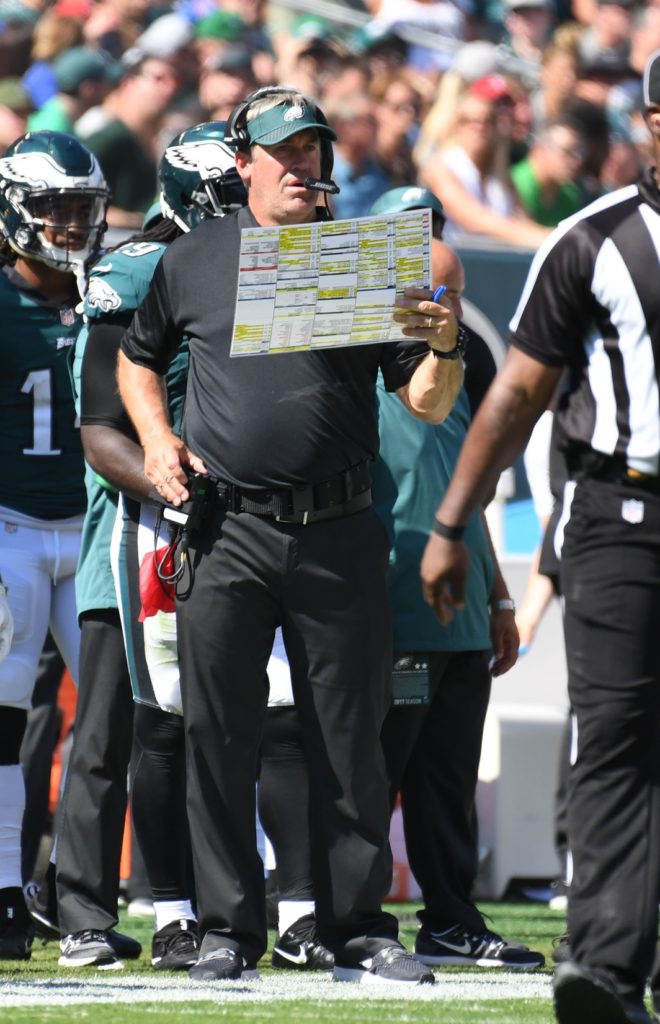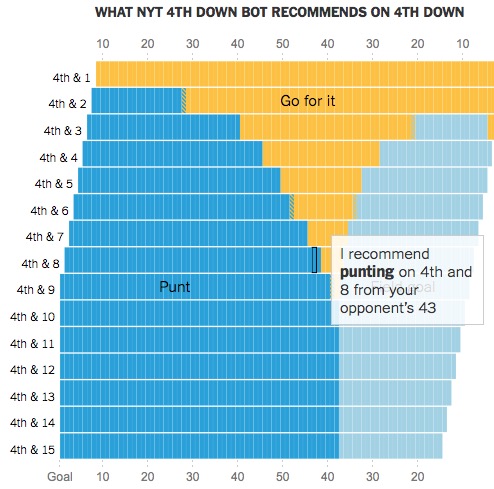Ad Disclosure
Fourth Dumb and 8
By Kyle Scott
Published:

Said Reich: “After [Pederson has] made the third-down call the phones can be silent for a few seconds, and one of the guys might chime in and say, ‘Hey coach, if this ends up short fourth-and-2,’ — I’m using fake terminology — ‘it’s green, go for it. The charts say go for it.’ Or, ‘Hey, if it’s anything less than fourth-and-3, we’re good. Other than that, it’s your call, Coach.’ Or, ‘Anything more than fourth-and-10, no.’
“The analogy I think of is kind of like a stoplight. There’s green, there’s yellow and there’s red, and then there’s shades of green, there’s shades of yellow and then there’s shades of red. So some of them are, ‘Hey, it’s green’; ‘yellow, proceed with caution,’ — and that’s how it operates.”
The fourth-and-8 from the Giants’ 43-yard line fell into the yellow section.
Based on this assessment, Doug Pederson’s very ineloquent explanation in his Monday press conference, and several articles yesterday attempting to defend the decision, including one by Jimmy Kempski, it was basically a coin-flip as to whether the Eagles should’ve gone for it… statistically speaking.
I’ll be the first to admit that perhaps I overstated things on Monday when I wrote “GTFO” in response to Doug’s explanation that analytics factored into his decision. Obviously, he was presented with a case to go for it. But the rest of the criticism still stands: it was dumb.
But Kyle, the numbers said it was, like, 50-50!
The way they arrive at this conclusion is by using a complex equation that not only factors in the basic guidance used by tools like the New York Times’ 4th down bot (which said not to go for it), but also the risk-reward in maintaining possession and potentially getting points on the drive vs. a ~30-yard field position swing. Generally speaking, the numbers say coaches should be much more aggressive than they typically are. It’s all quite fascinating, to be honest.
But, as best as I can tell from reading a lot about it over the past few days, these metrics are based on normal-flow-of-game situations and don’t factor in time and circumstance. And also, at best, they only consider Vegas lines when accounting for teams’ strengths. Needless to say, there are many other variables for which no metric can account. A sport like baseball, where each matchup can be broken down to a 1 vs. 1 event, is easier to predict using hard data. Hockey, in my opinion, is the hardest, given the countless variables going on at any given moment. Football likely falls somewhere in the middle.
You can see where analytical recommendations break down when you take them out to their extreme.
Though it’s likely more surface-level than what the Eagles are probably using, the 4th down bot recommends the following:

Now, should you punt on fourth and 12 down 10 with two minutes to go? No. Conversely, if you’re up 2 with 40 seconds remaining, does it really make sense to go for it on fourth and 2 from your own 28? Probably not, seeing as though a turnover on downs would likely lose you the game.
The midfield scenario in which the Eagles found themselves on Sunday wasn’t as cut and dry, but it was also unique for a number of reasons that analytics simply can not factor in. Among them:
- There was 2:36 remaining in the half with the Eagles up 7-0.
- They have an above-average punter who nearly pinned the Giants at the 1 earlier in the game. They likely would’ve come away with something better than a touchback.
- The Giants hadn’t scored a touchdown in 10 quarters to that point. They were struggling earlier in the game. And the Eagles were playing a conservative sag approach allowing the Giants to complete short underneath routes for 5 yards or so. All of those factors would have made a scoring drive – at least a touchdown – unlikely, given the relatively short amount of time the Giants had to work with.
- A turnover on downs, even on an incomplete pass rather than the moronic sack Carson Wentz took, would’ve put the Giants within 1-2 passes of field goal range.
There’s long been a debate between analytics folks and the “WATCH THE DAMN GAME!” crowd. Generally, the analytics folks have won out. But one area of debate has focused on the undeniable element of momentum. In this case, you had a team that had yet to score a touchdown on the season, which was struggling to get anything going on the road, and potentially facing almost the entire length of the field with only a short amount of time with which to work. Getting a turnover at midfield was a gift that injected life into the walking corpse of an offense. Never mind the fact that it put them in a 2-for-1 scenario, since they were due to get the ball after halftime. They could’ve potentially taken a 14-7 lead before the Eagles touched the ball again.
Kempski presented the following hypothetical to prove his point that going for it wasn’t a terrible idea:
Q: 1st/10, own 12 yd line. Would you call a play that 1/3 of the time will be INT at your 35, 2/3 of the time will be completed at your 43?
— Jimmy Kempski (@JimmyKempski) September 26, 2017
You can give yourself a headache trying to understand that, but the gist of it is that it’s more or less the scenario from the Giants’ perspective. If you screamed “No!” you wouldn’t go for it, congratulations, you’re sane. That answer also works to “prove” Kempski’s point that the Giants actually would’ve preferred that the Eagles punt there.
Two problems with this:
- The hypothetical of throwing a pass that has a 33% chance of being intercepted on first down presents a much different risk-reward platter than the reality of getting a momentum-swinging stop on fourth down– essentially a gift.
- I’m not so sure the Giants would have preferred the Eagles punt there, for all the aforementioned reasons. Even if they did, it doesn’t prove anything, because it relies on the very same subjective decision-making process that the analytics in question seek to disprove.
This isn’t to slam Kempski– his piece was the best I’ve seen in making the case for the Eagles to go for it. It was certainly better than Pederson’s.
But no matter how much you contort yourself into thinking it was the right decision, the best one can come up with is a 50-50 chance without factoring in the unique circumstance, which undeniably screamed “PUNT, YOU IDIOT!”
Keep hearing complaints about Eagles’ “analytics.” Fine to disagree w/ decision, but isn’t it irresponsible to NOT consider available data?
— Zach Berman (@ZBerm) September 27, 2017
Likewise for Berman– the data doesn’t explicitly say to go for it. It leaves the decision in the hands of the coach. Which brings us back to square one: the best use of data, in almost any circumstance, is to understand what it says and, more importantly, what it doesn’t say. It’s a fool’s errand to blindly trust a statistic. Any researcher will tell you this. Similarly, the best coaches will use the data on-hand to make an informed decision. Pederson, from my view, based on the rapidly accumulating sample size of his thought process, seems just stupid enough to screw things up.
Worse, he’s inconsistent.
Last year, he opted to punt with 6:34 remaining up 23-16 in Dallas, rather than kick a 53-yard field goal. Here’s the context-agnostic math on that one: field goals from that distance have around a 53% chance of being made. Here’s the context: Caleb Sturgis had already made one from 55 yards in that game, was kicking in essentially a dome, and a field goal would have all but guaranteed a win. My guess is that whatever complex equation the Eagles used would’ve told them to try the field goal. Doug punted, the Cowboys drove down the field and scored, and the Eagles lost in overtime.
Perhaps he was trying to make up for his field position play last year with his decision to go for it on Sunday. But each of those situations were unique, and Doug, incredibly, made the wrong decision both times– being conservative when he should’ve been aggressive (if you can even call a makable 53-yard field goal attempt to ice the game “aggressive”) and aggressive when all circumstances indicated that he should have been conservative.
This is my concern with Pederson, and the Eagles in general. You can have all the data in the world, but ultimately it’s what you do with that data that matters. Do you trust Doug Pederson as the person to handle it? I don’t.
Kyle Scott is the founder and editor of CrossingBroad.com. He has written for CBS Philly and Philly Voice, and been a panelist or contributor on NBC Sports Philly, FOX 29 and SNY TV, as well as a recurring guest on 97.5 The Fanatic, 94 WIP, 106.7 The Fan and other stations. He has more than 10 years experience running digital media properties and in online advertising and marketing.